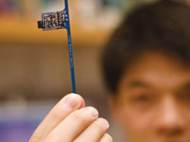RFID chips obtained computing skills
 Radio-frequency identification (RFID) chips have a problem related to the memory of their previous states because they reset their information every time they lose their external radio frequency power supply. Computer scientists from University of Massachusetts Amherst are working on software, fittingly named Mementos, which could allow an RFID to perform computations that span many power losses and reboots. The software may enable the chip to compute cryptographic protocols, leading to more secure signals. And it might allow RFID chips to be more than just data collectors.
Radio-frequency identification (RFID) chips have a problem related to the memory of their previous states because they reset their information every time they lose their external radio frequency power supply. Computer scientists from University of Massachusetts Amherst are working on software, fittingly named Mementos, which could allow an RFID to perform computations that span many power losses and reboots. The software may enable the chip to compute cryptographic protocols, leading to more secure signals. And it might allow RFID chips to be more than just data collectors.
They could analyze and possibly take action based on changes to the stress on a ”smart” bridge or to trends in a person’s vital signs, for instance. Such computational RFIDs (CRFIDs) could play a role in the transformation of the Internet from a network of computers to other networks of appliances, cars, smart clothes, etc.
”We’re working on software to make it possible to actually compute, given that our power is going to be disappearing and reappearing,” says Kevin Fu, assistant professor of computer science at the University of Massachusetts Amherst.
Mementos makes sure that the RFID keeps working toward finishing a computation, and it also keeps the chip in a state so if it loses power, it can quickly resume work when the power returns. One way the software does that is to have the chip perform energy-intensive tasks, such as writing data to flash memory, only when ample power (more than 2.2 milliwatts) is available.
”We have millions of computers everywhere, but computers have been chained to desks and server racks and other kinds of infrastructure,” said Ravi Pappu, co-founder of the RFID company ThingMagic. ”Rather than being constrained by dragging computers of various shapes and sizes into the real world, could we equip the real world with computing? I think what Kevin and his guys have done is an advance in that direction.”
Fu and his colleagues developed their RFID computing software on Intel’s prototype Wireless Identification and Sensing Platform (WISP), a postage-stamp-size RFID chip with specs suited for an 1980s computer: a 16 MHz microprocessor, 512 bytes of RAM, and 8 kilobytes of storage (in the form of flash memory).
The amount of RF power WISP picks up, Fu says, can vary drastically. And Mementos must make programs run on WISP perform under each scenario sleep (0.2 to 2.5 microwatts), inactive period; midrange (1.8 to 3.6 mW), which allows it to read from memory and compute; and active (2.2 to 25.2 mW) in which it can even write to flash memory.
”As much as possible we’d like to protect programmers from the underlying problems” of fluctuating power and regular reboots, says Benjamin Ransford, a graduate student in Fu’s lab.
Computational RFIDs will enable pervasive computation in places where battery-operated devices are difficult to maintain. The framework motivates the notion of computational checkpoints as a fundamental abstraction. The folks from Intel developed another version of the WISP that has improved RAM and storage memory. That helps proving the potential of this technology in the future, as the computing power of potential new devices relying on this technology could bare consumers’ appetites.









Leave your response!